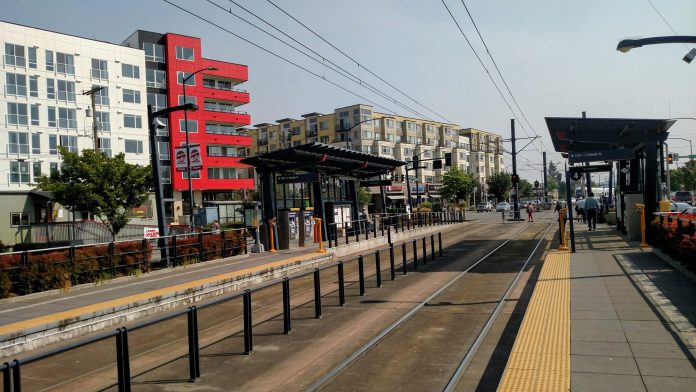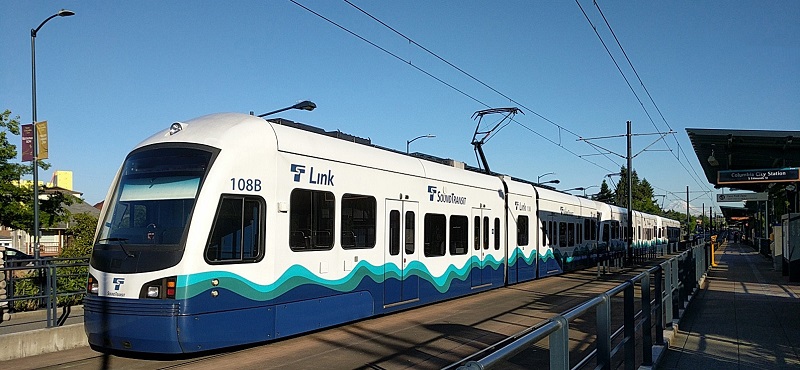
Sound Transit has been operating Central Link since 2009, and in that time period, the light rail line has been consistently plagued by collisions throughout the Rainier Valley where it crosses intersections at-grade. Of the 92 collisions along Martin Luther King Way, Jr. S, 69 have been with vehicles. Another 16 collisions have been with pedestrians. On average, a collision in the Rainier Valley occurs every 40 days.
Generally speaking, collisions are not the fault of light rail vehicle operators. Rather, a mix of the existing infrastructure and inherent conflict interaction with other road users lend the system to occasional collisions.
By design, light rail vehicles are supposed to have the right-of-way and equipment is installed along the at-grade sections to reduce the likelihood of collisions. For instance, some pedestrian crossings require opening of a gate or zigzagging to cross light rail tracks and blinking warning signs notify motorists of approaching light rail vehicles. Nevertheless, collisions are frequent and heavily concentrated in the Rainier Valley where the light rail line is not grade-separated.
Collisions create numerous problems:
- Collisions pose considerable safety risks obviously. Any time there is a pedestrian-train or bicyclist-train collision, the stakes are high for a fatality or severe injury. (Sound Transit says most pedestrian collisions are accidental incidents, not suicides or homicides.)
- Train-on-vehicle collisions often result in significant damage to the vehicle and train, and can lead to serious injuries or fatalities in vehicles.
- Collisions disrupt light rail service and often cause cascading impacts to the overall transit network. This will only be more problematic as light rail extensions are integrated into shared sections of the Central Link system.
- Longer-term impacts of collisions can mean that light rail vehicles have to be taken out of operation for extended periods of time for repair (typically about three weeks). That can put Sound Transit in an operational crunch.
- Collisions can create exposure to high financial liabilities.
- Additionally, even when collisions are averted, train operators may be forced to slam on the breaking system, which can be incredibly abrupt to passengers, risking their safety. Likewise, near-collisions for bicyclists and motorists can still result in personal injuries.
In terms of service disruptions in the Rainier Valley, part of the reason why collisions are so acute in system-wide disruptions is that Sound Transit has to close at least one track and reroute trains off the affected track. Crossover tracks in the Rainier Valley are spread across the corridor near S Walden St, S Othello St, and Rainier Beach Station. However, that is not enough to minimize the inevitable service impacts.
What the data indicates
Data procured from Sound Transit indicates that the Central Link line has had 111 collisions since its opening in 2009 and April 16, 2019. Approximately one collision happens every 36 days along the line. The frequency of collisions is particularly acute in the Rainier Valley where the bulk of the collisions–more than 80%–occur every 40 days. Approximately 17.4% of collisions in the Rainier Valley are with pedestrians and another 75% are with vehicles, largely at intersections.
The S Dawson St intersection is a chronic location for vehicle collisions. Eleven of the 69 reported vehicle collisions have occurred there, representing about 16% of the Rainier Valley vehicle collisions with light rail. Intersections along the corridor, however, have almost all experienced several vehicle collisions.
In terms of pedestrian collisions, the S Graham St intersection has seen the most number of collisions with four such incidents. That represents a full quarter of Rainier Valley pedestrian-train collisions, making it a target location for interim improvements. A future infill Graham Street Station is planned there in 2031. The bulk of the remaining pedestrian-train collisions stretches south to S Othello St. Notable among this is that the Othello Station has managed to have two pedestrian-train collisions.
However, pedestrian-train collisions are not just limited to the Rainier Valley. S Holgate St is an especially pernicious location in SODO, claiming nine pedestrian-train collisions. Three other pedestrian collisions have occurred north of the crossing (one each at Pioneer Square Station, University Street Station, and the E-3 Busways at S Royal Brougham St). Nearly half of the collisions in SODO and points north have been with pedestrians, which makes that stretch especially important for pedestrian safety improvements.
Improving safety and performance

To date, Sound Transit has chosen to maintain the at-grade crossings throughout the Rainier Valley without automated crossing gates and other major safety interventions. Motorists, the chief problem to light rail operations, are only provided with the warning signs of approaching trains. However, some safety improvements are on the way to the at-grade sections of the system.
“Sound Transit is installing cameras at key locations to improve safety. In the next few months, we will be reducing the speed through [S Holgate St],” said John Gallagher, a Sound Transit spokesperson. “We are also installing bi-directional warning signs. These flashing signs will warn pedestrians that a second train is also coming, which they may not be able to see because of the first train passing. These improvements will be implemented in Rainier Valley and SODO.”
The result of these changes does mean that collisions with pedestrian may be somewhat reduced, but it will also increase delay to passengers on individual trips. Sound Transit could go much further to increase safety while improving overall system performance. Both of these objectives are critically important because as the system expands because collisions will hamper operations on the Central Link and East Link lines–the latter which will only share tracks north of S Royal Brougham Way and have no at-grade rail sections–and continue to put heavy pressure on the bus system.

For pedestrians, Sound Transit could consider installation of more barriers wherever at-grade crossings of tracks occur. Fencing to force pedestrian to zigzag and static signs to notice the crossings are not sufficient. Automatic gates or manually opened gates and more median refuge areas coupled with the planned second train flashing warning signs would be better strategies to prevent collisions.
For motorists and bikes, Sound Transit could also consider automatic gates at intersections in addition to closing additional at-grading crossings at intersections. In constructing the Rainier Valley alignment, Sound Transit had closed dozens of intersections where vehicles might otherwise cross over tracks. The primary drawback of this, however, was locking out people walking and biking from crossing Martin Luther King, Jr. Way S.

Portland has led the way with the use of automatic gates, similar to regular freight and passenger rail lines. When Trimet opened the MAX Orange Line in 2015, it had several at-grade sections outside of Downtown Portland to contend with. The transit agency sought to improve speed, reliability, and safety by installing automatic gates to prevent collisions with similar circumstances to the center-running alignment in the Rainier Valley.

Making these collective improvements not only could safety improve along the corridor, but light rail speeds could be increased in the Rainier Valley if these types of measures were deployed. To do so would not require a massive level of investment from the North King Subarea, likely in the range of $15 million to $30 million.
However, Sound Transit said there are no planned investments on the horizon to do so, beyond the aforementioned minor safety projects. “It would represent a major undertaking to contemplate the feasibility of such an extensive capital project from standpoints including public safety, financing, traffic operations, and support from the community and City of Seattle,” Gallagher said. “Financially, the Sound Transit 3 ballot measure did not fund a project of this nature.”
In the context of saving lives, reducing injuries and property damage, system reliability, and improving ridership, a deeper look into greatly improving the at-grade sections of the light rail should be a top priority of Sound Transit.
Data visualization and collection was provided by Adam Dodge. Sound Transit is the data source.
Stephen is a professional urban planner in Puget Sound with a passion for sustainable, livable, and diverse cities. He is especially interested in how policies, regulations, and programs can promote positive outcomes for communities. With stints in great cities like Bellingham and Cork, Stephen currently lives in Seattle. He primarily covers land use and transportation issues and has been with The Urbanist since 2014.

